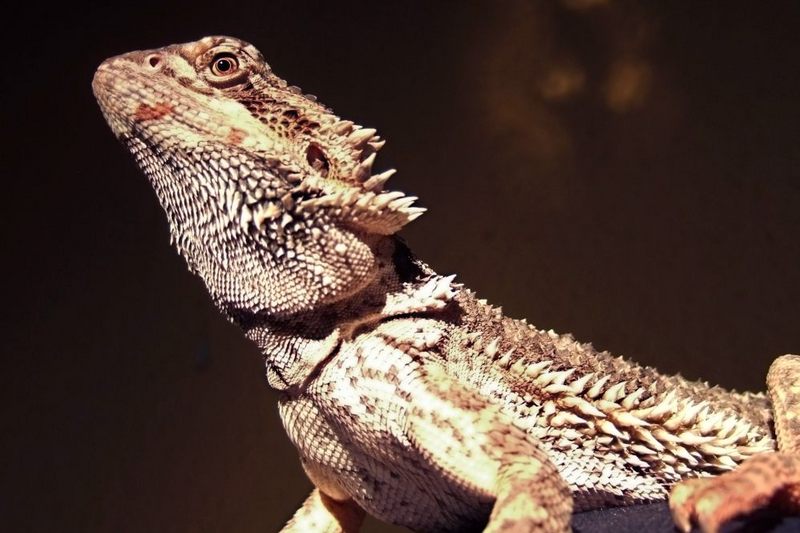Bearded Dragon (Pogona sp.) - Wiki Bearded Dragon
From Wikipedia, the free encyclopedia
[Photo] Pogona vitticeps, 10 months. Author: Galak76. Date: 20 January 2007 (UTC)
Bearded Dragon is the common name for any agamid lizard in the genus Pogona. Bearded Dragons are popular exotic pets in many places, notably the Inland Bearded Dragon. They are quickly gaining popularity and may soon be more common pets than green iguanas.
Characteristics
Bearded dragons have broad triangular heads and flattened bodies, with adults reaching approximately 50 cm (19.5 inches) head-to-tail. Males are slightly longer than females, but females are slightly heavier. They owe their name to a distinctive series of lateral spines (specialized scales) radiating horizontally from the head and base of the tail. As juveniles, they are semi-arboreal. As adults, they are mostly terrestrial but climb to bask and search for prey. They inhabit mostly open woodlands, scrubland, and desert.
Distribution and life span
All species are native to Australia, but they have been exported worldwide; and due to their convenient size, hardiness, and omnivorous diet, they are popular reptile pets. They are one of the most popular pet lizards in the United States and Canada. Bearded Dragons live for 8-12 years with proper care. Some owners reported bearded dragons that lived 15 years. The life span depends on the quality of their lives (correct temperature, lighting, diet and care). A good substance to house Bearded Dragons on is washed play sand. Solid substrates, such as paper towel (for babies) or non-adhesive shelf liner are considered the safest. This is because of the risk of impaction, which occurs when too many indigestible particles have been ingested and are clogging the digestive tract. Like many reptiles, bearded dragons require UVB/UVA as well as a heat source.
Feeding
Bearded dragons are omnivorous, meaning they eat both insects and plants. The ideal staple for these lizards are gut-loaded crickets (gut-loaded meaning pre-fed before feeding them to your lizard for at least 24 hours; do not go for vegetables or scraps as these are not nutritious to your bearded dragon). Commercial gut-load cricket foods are available [1]. Mealworms are not healthy for bearded dragons, for they have a hard outer shell and are hard to digest at improper temperatures. Feeding too many mealworms may lead to a deadly impaction due to high levels of chitin. Silkworms, and crickets dusted with calcium powder and the occasional multi-vitamin are the best choice of staples for a healthy staple diet. Do not feed bearded dragons mice, anoles, or other feeder animals. These cause impaction and can block the bearded dragons airways with the tiny bones.
Bearded dragons also eat a variety of leafy greens. Collard greens being a favourite among many. Examples of everyday greens are as follows: collard greens, mustard greens, squash (acorn, scallop, hubbard, and summer), turnip greens, alfalfa plant, roman lettuce, and parsley. A mixture of these plants make a delicious salad for a bearded dragon to enjoy.
A common problem with bearded dragons as pets is their refusal to eat vegetables. Usually this can be solved quickly by mixing greens with crickets or worms.
Species
Recognized species of bearded dragons:
- Eastern or Common bearded dragon, Pogona barbata
- Black soil bearded dragon, Pogona henrylawsoni
- Kimberly bearded dragon, Pogona microlepidota
- Western bearded dragon, Pogona minima
- Dwarf bearded dragon, Pogona minor (some authorities group this with Pogona minima)
- Northwest bearded dragon, Pogona mitchelli
- Nullabor bearded dragon, Pogona nullarbor
- Central or Inland bearded dragon, Pogona vitticeps, the most commonly kept pet.
The beard
Bearded Dragons can puff out the spiny protrusions under their chin. This is normally used as a defense measure to make the lizard look larger than it really is. They may bob their heads or wave either of their forearms as communication.
Breeding
Due to domestication, beardies have exhibited rather unique colorations. These "designer" dragons display brilliant hues of pastel oranges, violets, and reds. The most popular morphs thus far has been the "sand fire" and "tiger" dragons. Much like designer dogs, the price tags of these customized pets are many times the price of "generic" ones. Currently, breeders are working towards and showing some progress of developing a green morph. Since breeding beardies is a relatively new area, it may take some time before that dream of a green dragon is fully realized.
Personality
Bearded dragons are known to be very docile and trusting, yet at the same time, outgoing and curious lizards. Their behaviour includes body language such as head bobbing and leg waving. Some owners have mimicked these behavioral patterns and have successfully aroused a mirrored response in their dragons.
Captivity habitat
A popular size enclosure for baby bearded dragons is 20 gallons; adults require enclosures of 40 gallons and larger, with 8 square feet of floor space being preferable. An average life span for a bearded dragon is eight to ten years. Thus bearded dragons should be upgraded to adult-sized enclosures within the first year of life.
Diseases
When provided with the proper habitat, temperatures and UVB lighting, bearded dragons are hardy lizards. They are also pets who do their best to hide health problems when becoming ill (as do most reptiles). This is probably an instinctual behavior, since a sick dragon in the wild would probably not live long. The most common diseases they get are: mites, terminal ingestion, thermal burns, calcium deficiency, impaction, hypovitaminosis A, respiratory infections, dehydration, stomatitis, internal parasites, coccidia and other parasites, dystocia (egg binding), and MBD (Metabolic Bone Disease).
http://en.wikipedia.org/wiki/Bearded_Dragon
| The text in this page is based on the copyrighted Wikipedia article shown in above URL. It is used under the GNU Free Documentation License. You may redistribute it, verbatim or modified, providing that you comply with the terms of the GFDL. |
